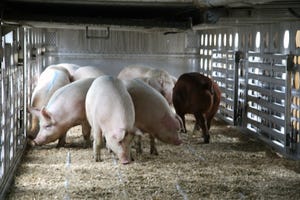U.S.-China trade talks resume in October
Legislative Watch: U.S.-China back at the table; appropriations on Congress schedule; net farm income increasing; Australian pork coming to U.S.

The top trade officials of the United States and China will meet early October in Washington, D.C., to resume trade negotiations. This announcement comes after a new round of tariffs and increased heated rhetoric in the ongoing escalation of the trade war. This will be the first face-to-face meeting since July.
The importance of reaching an agreement was emphasized by American Farm Bureau Federation President Zippy Duvall, saying “While the latest Chinese tariffs are no surprise, they are no more welcome than before. The Trump administration must focus on keeping the negotiations with China on course to resolve this trade war.
“We appreciate efforts by the U.S. Trade Representative and the agriculture department to open new markets and expand others. Farmers and ranchers are grateful for mitigation payments, too. For many, those payments are the single-most critical factor in their ability to stay in farming for a little while longer. But let’s be clear: those payments do not make them whole, especially with additional challenges from Mother Nature. Many farmers and ranchers cannot withstand continued uncertainty in trade. We must restore and expand markets.”
China recently announced measures to boost domestic consumption and strategies to increase the countries manufacturing capabilities in an effort to insulate itself from the effects of the trade war.
Congress returns with time ticking on fiscal year
Congress returns next week from the summer recess with only 13 legislative days before the end of the fiscal year. The Senate is expected to begin consideration of Fiscal Year �’20 appropriation bills. The House of Representatives has passed 10 of the 12 appropriations bills. With such a short time before the end of the fiscal year, the House of Representatives plans to pass a short-term continuing resolution the week of Sept. 16 to keep the federal government running.
The key issue for agriculture is Congressional consideration of the U.S.-Mexico-Canada Agreement. USTR and the House Democratic USMCA working group have been meeting throughout the summer recess to try and reach an agreement that will allow a Congressional vote on the trade agreement before the end of the year. It is critical that Congress vote on USMCA this year otherwise election year politics will take over and the agreement could languish until after the 2020 election.
Net farm income estimated to increase
USDA’s Economic Research Service is estimating net farm income to increase to $88 billion, a 4.8% increase over last year. When adjusted for inflation it is $86.5 billion, an increase of 2.9%. Net farm income was $136.5 billion in 2013. The average net farm income from 2000-18 was $90 billion.
The increase is primarily due to $19.5 billion in direct government payments, including the $13 billion in trade mitigation payments. This is a 43% increase in direct government payments. Crop insurance payments are not included in ERS’ forecast. Without federal payments, farm income would total $69 billion this year.
Australia can export raw pork products to U.S.
USDA’s Food Safety and Inspection System reviewed Australia’s raw pork inspection system and determined it is equivalent to the U.S. inspection system. Australia will now be allowed to export raw pork to the United States from swine slaughtered on and over Aug. 29.
Source: P. Scott Shearer, who is solely responsible for the information provided, and wholly owns the information. Informa Business Media and all its subsidiaries are not responsible for any of the content contained in this information asset.
About the Author(s)
You May Also Like



